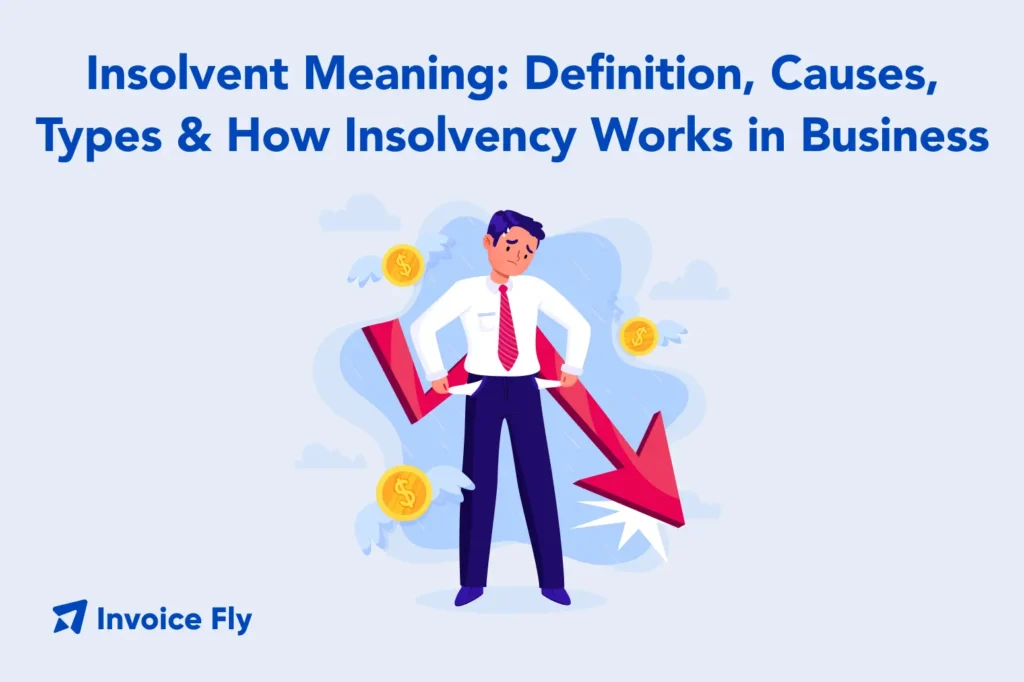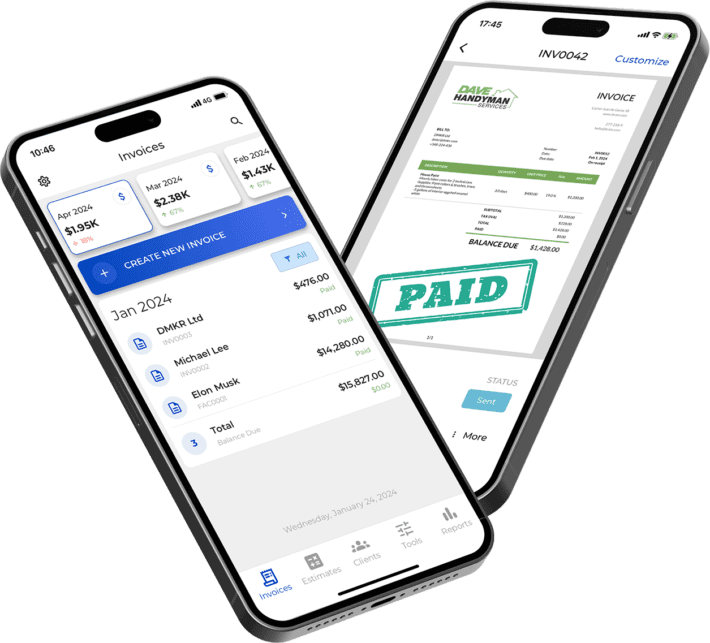Insolvent Meaning: Causes, Types & How Insolvency Works in Business

Table of Contents
Being insolvent means that a person or business can’t pay their debts when they’re due. It’s a serious financial situation that can lead to legal action, business closure, or restructuring. But insolvency doesn’t always mean the end — understanding how it works, what causes it, and how to manage it can help you recover or prevent it altogether.
In this guide, we’ll explain what insolvent means, the types of insolvency, the role of insolvency practitioners, and what steps you can take to handle financial distress responsibly.
Get Started with Invoice Fly’s Software
Invoice Fly is a smart, fast, and easy-to-use invoicing software designed for freelancers, contractors, and small business owners. Create and send invoices, track payments, and manage your business — all in one place.

What Does Insolvent Mean?
Insolvent means your liabilities (what you owe) are greater than your assets (what you own), or you simply can’t pay bills when they’re due. In short, you’re unable to meet your financial obligations.
The definition of an insolvent business is straightforward: when a company cannot satisfy creditor demands as debts become due. In business terms, insolvency can be temporary — for example, when a company is waiting on client payments but has immediate bills to pay — or long-term, if debts continually outweigh income.
There are two main ways to understand insolvency:
- Cash-flow insolvency – when you don’t have enough liquid funds to pay debts on time.
- Balance-sheet insolvency – when your total debts exceed your total assets.
The IRS defines insolvency as a condition where total debts exceed the fair market value of total assets. This matters especially for tax situations like debt cancellation or when completing Form 982 and the insolvency worksheet (IRS: What If I Am Insolvent?).
U.S. Tax Note: If a lender cancels or forgives debt, you may need Form 982 to report reduced tax attributes. The IRS uses the balance-sheet test to determine insolvency.
If you’re unsure about your financial health, review your balance sheet and income statement regularly — both can be created easily with tools like Invoice Fly’s Business Reports.
Synonyms for insolvent: bankrupt (informal), unable to pay debts, broke (informal), over-leveraged, underwater. Legal usage varies by country — use official definitions in filings.

Signs of Insolvency
Spotting early warning signs of insolvency can help you act before it’s too late. Here are some red flags to watch for:
- Consistent cash flow issues — struggling to pay suppliers, rent, or payroll on time.
- Growing debt levels — relying on loans or credit cards to cover daily expenses.
- Declining profits — when revenue drops while expenses stay high.
- Supplier pressure — receiving payment reminders or threats of legal action.
- Asset sales — selling equipment or stock just to stay afloat.
- Overdue taxes — failing to pay income or sales taxes on time.
- Banking insolvency warnings — receiving notices from your bank about overdrafts or frozen accounts.
If these signs sound familiar, review your company’s cash flow management and consider restructuring your debt or consulting an insolvency practitioner.

Types of Insolvency
Not all insolvency situations are the same. Understanding which type applies helps determine the right recovery approach.
Cash Flow Insolvency
Cash-flow insolvency occurs when a business or individual has assets but not enough liquid cash to pay immediate debts. For example, your business may own valuable equipment or property but can’t convert those assets quickly enough to pay suppliers.
Insolvent vs illiquid: Illiquid means you have assets you can’t quickly sell; insolvent means you can’t meet debts when due or your liabilities exceed assets — a legal threshold with consequences according to Allianz Trade.
Short-term financing, better invoicing, or renegotiating payment terms can restore stability. Learn to manage payments effectively in our guide on invoice payment terms.

Balance Sheet Insolvency
Balance-sheet insolvency happens when liabilities exceed assets — meaning the company owes more than it owns. This is often the point where liquidation or restructuring becomes necessary.
Legal definitions vary, but in many countries, according to Cornell Law School, the balance-sheet test determines when formal insolvency proceedings must begin.
Voluntary vs. Involuntary Insolvency
Insolvency can also be voluntary or involuntary:
- Voluntary insolvency – when the debtor (individual or company) recognizes they can’t pay debts and initiates legal proceedings or restructuring through an insolvency petition.
- Involuntary insolvency – when creditors (those owed money) take legal action to recover their debts, often forcing the debtor into liquidation or administration.
Tip: Understanding how your accrual basis accounting reflects revenue and obligations can prevent surprise cash-flow gaps that lead to insolvency.
Causes of Insolvency
Insolvency can stem from poor financial management, economic downturns, or unforeseen costs. Common causes include:
- Poor bookkeeping — not recording journal entries correctly.
- Excessive borrowing — relying too heavily on credit without managing your ledger balance.
- Declining sales — loss of clients or reduced spending affecting gross profit vs net profit margins.
- High overheads — rent, utilities, or payroll exceeding revenue.
- Late payments from clients — disrupting cash flow and profitability.
- Economic shifts — inflation or interest-rate spikes causing financial distress.
Tip: Review our small business bookkeeping guide for best practices that prevent insolvency triggers.
The Insolvency Process
Once a company becomes insolvent, the process typically includes several steps, managed by licensed professionals.
Typical Insolvency Process
- Assessment & advice — Collect statements and seek guidance from a licensed insolvency practitioner (IP).
- Stabilize cash — Freeze non-essential spend, negotiate with key creditors, and improve collections.
- Choose a route — Informal workout, company voluntary arrangement, administration, or liquidation.
- Notify stakeholders — Employees, secured lenders, and tax authorities.
- Execute & report — The IP handles asset sales, claim distributions, and compliance filings.
Role of Insolvency Practitioners
An insolvency practitioner is a licensed professional who manages the process ethically and fairly, following a Statement of Insolvency Practice (SIP). Duties include:
- Reviewing financial records and creditor claims.
- Developing recovery or restructuring plans within the insolvency law framework.
- Managing liquidation or dissolution if necessary.
- Ensuring fair asset distribution to creditors.
- Investigating culpable conduct or fraud if suspected.
In the U.S., similar roles are filled by bankruptcy trustees or court-appointed receivers.
If you’re unsure where to start, search for a personal insolvency practitioner or regulated firm in your region.
Legal Consequences of Insolvency
The legal implications of insolvency depend on your country’s insolvency law and the type of entity involved, but generally include:
- Asset seizure or liquidation – selling assets through administration to repay creditors.
- Creditor priority – secured creditors (like banks) get paid before unsecured ones through a specific order established by law.
- Court proceedings – formal insolvency proceedings or bankruptcy hearings initiated by petition.
- Director liability – in some cases, directors of insolvent companies can be held personally liable if they continue trading while knowing about insolvency, which may be considered culpable conduct.
- Credit rating impact – insolvency can severely affect your future ability to borrow or get contracts, and may trigger insolvency protection measures for creditors.
Who gets paid first (typical order):
- Secured creditors (to collateral value)
- Preferential claims (employees, taxes)
- Unsecured creditors
- Shareholders (if anything remains)
Learn more: IRS guidelines for insolvent taxpayers and IRS Manual 1.4.51 explain administrative procedures.

How to Handle Insolvency
If you or your business is becoming insolvent, take responsible action:
- Review your finances – assess cash flow using your profit and loss statement.
- Negotiate with creditors – request extended payment terms or settlements.
- Cut costs – use expense reports to identify savings.
- Seek professional advice – from an IP or accountant familiar with insolvency protection.
- Restructure – reorganize debts or operations.
- Avoid new debt – focus on stabilization before new borrowing.
- Keep records – maintain invoices vs receipts properly for transparency.
Improve visibility with Invoice Fly’s Business Reports to generate cash-flow, profit, and loss reports instantly.
Conclusion: Insolvency Doesn’t Always Mean the End
Insolvency is a tough financial situation, but it doesn’t have to spell disaster. Understanding the insolvency definition and recognizing warning signs early can make all the difference. Many businesses bounce back by seeking professional help, making strategic changes, and using proper financial tools to regain stability.
Whether you’re dealing with personal or corporate insolvency, the key is acting quickly and responsibly. By staying on top of your cash flow, using reliable bookkeeping tools, and consulting with qualified insolvency practitioners when needed, you can often restructure and recover — or at least exit gracefully with minimal legal consequences.
Get Started with Invoice Fly’s Software
Invoice Fly is a smart, fast, and easy-to-use invoicing software designed for freelancers, contractors, and small business owners. Create and send invoices, track payments, and manage your business — all in one place.

FAQs About Insolvency
Going into insolvency means an individual or business cannot meet debt obligations as they fall due. It may trigger legal insolvency proceedings such as liquidation, bankruptcy, or restructuring through administration.
You qualify as insolvent if you either can't pay debts as they're due (cash flow test) or your liabilities exceed your assets (balance sheet test). The IRS insolvency form uses the balance sheet definition for tax purposes.
Claiming insolvency often initiates formal proceedings managed by an insolvency practitioner. Assets may be sold to pay creditors through a structured process, and certain debts could be discharged or reduced depending on the type of insolvency and applicable law.
Secured creditors (like banks with collateral) are usually paid first in the creditor priority order, followed by unsecured creditors, employees, and finally shareholders. The exact order depends on local insolvency acts and regulations.
It depends on the complexity of the case — personal insolvency can last a few years, while corporate insolvency proceedings may take months or several years to resolve completely through the dissolution or restructuring process.

